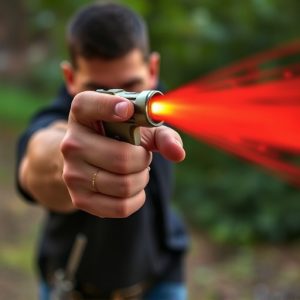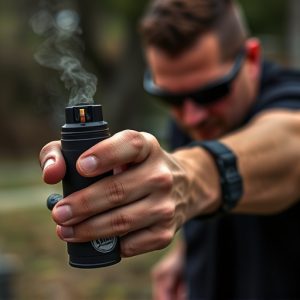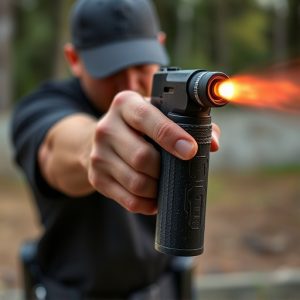Neutralizing Pepper Spray: Law Enforcement Grade Devices & Face Protection Strategies
Pepper spray, containing capsaicin or oleoresin capsicum (OC), causes immediate reactions upon facia…….
Pepper spray, containing capsaicin or oleoresin capsicum (OC), causes immediate reactions upon facial exposure. To neutralize pepper spray on the face, follow these steps: seek safety, remove contaminated clothing and glasses, rinse with cool water for 15 minutes, apply soap or eye wash, gently massage the area, and consider protective eyewear. Law enforcement grade pepper spray devices are designed to disrupt vision, breathing, and movement temporarily, featuring long-range spray mechanisms, robust construction, and durable casings. These tools enable officers to respond swiftly, minimizing collateral damage while providing time for control and arrest procedures.
“Discover the power and purpose of law enforcement-grade pepper spray, a critical tool in modern policing tactics. This article explores its impact on the human body and how specialized devices are designed to maximize effectiveness while minimizing risks. We delve into practical strategies for individuals facing pepper spray assault, focusing on neutralizing techniques for the face – a crucial skill in self-defense and law enforcement scenarios. Learn how to stay safe and navigate these potent substances.”
- Understanding Pepper Spray and Its Impact on the Body
- The Design and Functionality of Law Enforcement Grade Pepper Spray Devices
- Effective Strategies for Neutralizing Pepper Spray on the Face
Understanding Pepper Spray and Its Impact on the Body
Pepper spray, a powerful law enforcement tool, is designed to disrupt and disable individuals through targeted irritation. When deployed, it releases a fine mist containing capsaicin, the active ingredient found in chili peppers. This substance stimulates nerve endings, causing an intense burning sensation and temporary incapacitation. The impact is rapid, leading to coughing, tears, and difficulty breathing—effects that subside once the spray is no longer in contact with the body.
Understanding how pepper spray interacts with the body is crucial for both law enforcement officers and individuals seeking to neutralize it. On the face, for instance, it can cause severe discomfort, blurring vision, and making it challenging to breathe or speak. To counter this, removing contaminated clothing and washing the affected area with soap and water are immediate steps. However, in cases where pepper spray is inhaled, seeking fresh air promptly becomes essential to mitigate its effects.
The Design and Functionality of Law Enforcement Grade Pepper Spray Devices
Law enforcement grade pepper spray devices are meticulously designed to neutralize pepper spray on face and disrupt an assailant’s vision, breathing, and movement for a short period, allowing officers to gain control and subdue them. These advanced weapons typically employ a unique combination of chemicals, such as capsaicin or oleoresin capsicum (OC), which are sprayed in a fine aerosol form. The design focuses on delivering a high concentration of these irritants directly into the eyes and respiratory system, ensuring maximum effectiveness while minimizing collateral damage to surroundings.
The functionality of these devices is optimized for tactical use. They often feature a long-range spray mechanism, allowing officers to engage targets from a safe distance. Additionally, they are built with robust construction to withstand rigorous field conditions. Key components include a powerful air compressor, a precision nozzle system, and a durable casing that protects the spray canister. These features enable officers to swiftly respond to threats, neutralizing pepper spray on face and providing crucial time for control and arrest procedures.
Effective Strategies for Neutralizing Pepper Spray on the Face
When faced with pepper spray, quickly and effectively neutralizing it on your face is crucial for self-defense and recovery. The first step is to immediately seek a safe location, preferably indoors or in an area where the wind isn’t blowing directly towards you, as this can exacerbate the irritation. Remove any glasses or contact lenses to prevent them from fogging up, which can obscure your vision. Then, rinse your face with cool water for at least 15 minutes. Pepper spray is typically composed of capsaicin, so cooling down and diluting it is key to neutralizing its effects.
After rinsing, apply a neutralizing agent like soap or an eye wash solution designed for pepper spray removal. Gently massage the affected area to help flush out any remaining chemicals. Avoid rubbing your eyes as this can further irritate them. Consider keeping a small bottle of eye wash or a neutralizing gel in your emergency kit or on your person for quick access during encounters. Additionally, wearing protective eyewear during situations where pepper spray might be used can offer an extra layer of defense against direct exposure to the eyes and face.
In understanding the impact of pepper spray, its design in law enforcement settings, and effective strategies to neutralize it on the face, individuals can better prepare for and respond to potential exposure. By recognizing the unique challenges and equipping themselves with practical techniques, they can enhance their safety and resilience when faced with this potent agent. Remember that knowledge is key; staying informed about these tactics ensures a calmer, more strategic response during critical situations involving pepper spray.


